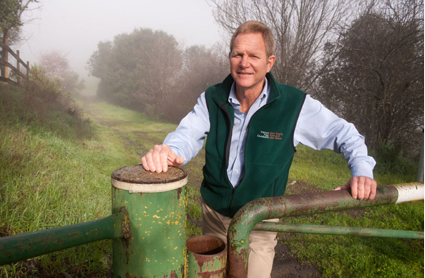As a Marin County supervisor, Steve Kinsey makes just under $120,000 a year including benefits and allowances. At first glance, considering Marin has five supervisors and a little more than 250,000 residents, that’s hardly a taxing task. Do the math: that is around 50,000 people per supervisor. Can’t be too tough.
However, let’s look closer. In addition to being on the Board of Supervisors, the 58-year-old Kinsey serves on—and must be conversant with the actions of—some 37 Marin commissions, committees and authorities. They include Marin’s Open Space District, Children’s Health Initiative Committee, Countywide Planning Agency, the Marin Housing Authority, Emergency Radio Authority, the Marin Agricultural Land Trust and the Marin/Sonoma Narrows Policy Advisory Committee. And the area he represents, District 4, stretches from West Marin to San Quentin and covers nearly two thirds of the county. On average, that’s eight times larger than the other supervisorial districts.
“It’s not a job,” Kinsey says of the seat he’s occupied since 1997 and will hold until at least 2012 when he’s up for reelection. “I call it a lifestyle because if you are not in a meeting or at an event or attending a hearing, you’re thinking about one of the many things that are constantly going on. There’s no such thing as a five-day workweek—there’s always something.”
As much as he now relishes his role in the county, Kinsey once went to extremes to not be considered a candidate for supervisor: “I wore a bushy ponytail so no one would ask me to run for office.” Further testifying to his independence, though Kinsey considers himself a staunch environmentalist, he has never had the support of the Sierra Club.
Regardless, his grassroots efforts to stifle a 1,600-acre West Marin development, pass a measure ensuring a conservation-oriented and economical water supply for Marin, and then successfully guiding design and funding for an elementary school in the San Geronimo Valley caught the eyes of Marin’s power brokers. Long hair and all, they asked Kinsey to run for the seat opened by Gary Giacomini’s retirement after 24 years. “I wanted to give it a try, so off went my ponytail,” Kinsey says.
Kinsey, an architectural graduate of Arizona State University, and his partner, Jean, have lived in Forest Knolls for nearly 35 years. Their son, Breeze, with his girlfriend and her dad, recently opened the Golden Orb, which Kinsey describes as a “hole-in-the-wall piroshki restaurant on Fourth Street in San Rafael—and it’s really good.”
Many are concerned the county’s agricultural industry—centered in West Marin—is not doing well. What can improve this situation? What we want are prosperous families continuing the farming tradition. To do that we need to help our producers transition from an exclusive commodity business model—such as dairy or beef cattle raising—into one built upon value-added, diversified use of their land. The epitome of this would be Bob Giacomini, who went from being exclusively dairy farmers to founding the Point Reyes Farmstead Cheese Company, one of the most successful businesses of its kind west of the Mississippi. Another example is Sharon and Steve Doughty, who now have a vineyard and a bed and breakfast on their land in addition to their dairy.
Also, and little by little, we are becoming the cheese version of the Napa Valley’s wine country. We want to be the region where people recognize the special cheeses that are produced here. Diversifying also brings benefits to the environment because by incorporating extra value elements, ranchers can reduce their herd size which, in turn, makes for less impact on the land. This is an ecologically beneficial means of continuing our prosperous agricultural tradition.
When you say “we’ll get there” and “we’re working,” who is the “we”? “We” is an amazing dream team that includes Marin County’s Agricultural Commissioner; the UC Ag Extension, the Marin Agricultural Land Trust (MALT), Marin Organic and the Marin Agricultural Institute, more commonly called the Marin County Farmers Market. All of these organizations provide services to ranchers helping them to be viable and meet various environmental regulations. This collaborative approach helps our food get from farm to family in a way that the farmer is able to capture some of the retail value of his crops instead of just the wholesale value. In that same spirit, I’ve been working overtime to create a permanent farmers’ market here at the Marin County Civic Center grounds.
You voted against the county guaranteeing a $950,000 loan to get the Marin Energy Authority up and running. Why? There were two reasons for my no vote. First, if we have some eight Marin agencies—including seven cities—anxious to see Marin Clean Energy work, why is the county the only one being asked to put money at risk? Second, a PG&E-backed constitutional amendment, Proposition 16, will be on the June ballot and if it wins, the change in law will virtually wipe out any cumulative benefit of Community Choice Aggregation (CCA), the statewide concept that the Marin Energy Authority is based on. The timing is such that MEA would then be left with only 20 percent of Marin’s potential market. That’s not enough to succeed.
You don’t sound optimistic that Marin Energy Authority will succeed. I don’t want to be a naysayer, but I believe MEA is up against enormous odds. PG&E is putting $30 million into passing Prop. 16 in an election cycle where conservative voters have a lot to look at in terms of a new governor while Democratic voters have little to draw them to the polls. If Prop. 16 passes, two thirds of the electorate majority will be needed to form additional energy authorities. Thus, the MEA business model will be completely castrated. Given those risks, I simply wasn’t willing to put more Marin County funds at risk when we are reducing services, laying off employees and facing even deeper cuts from the state of California.


